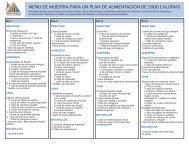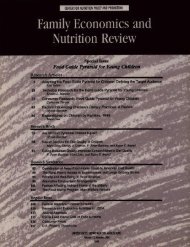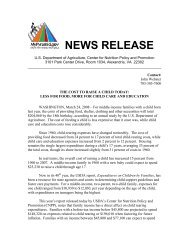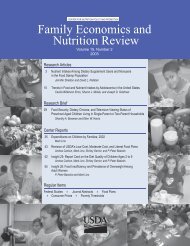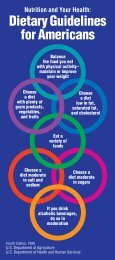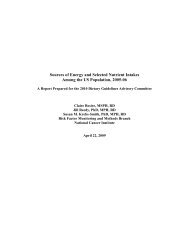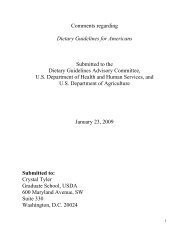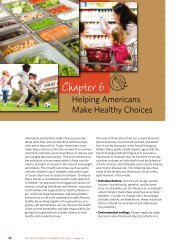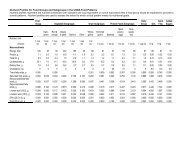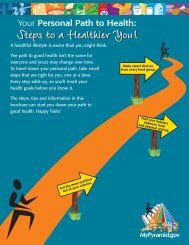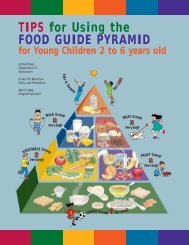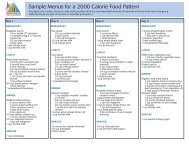Elderly Nutrition - Center for Nutrition Policy and Promotion - US ...
Elderly Nutrition - Center for Nutrition Policy and Promotion - US ...
Elderly Nutrition - Center for Nutrition Policy and Promotion - US ...
You also want an ePaper? Increase the reach of your titles
YUMPU automatically turns print PDFs into web optimized ePapers that Google loves.
Consensus Development Panel on<br />
Osteoporosis Prevention, Diagnosis,<br />
<strong>and</strong> Therapy (NIH, 2001). From a review<br />
of 2,449 references from 1995 to 1999,<br />
the panel identified several modifiable<br />
risk factors <strong>for</strong> osteoporosis <strong>and</strong> bone<br />
fractures, including smoking, a low<br />
level of physical activity, risk of falling,<br />
<strong>and</strong> low intakes of calcium <strong>and</strong> vitamin<br />
D. Further evidence that smoking <strong>and</strong><br />
use of smokeless tobacco are risk<br />
factors was recently reviewed<br />
(Spangler, Qu<strong>and</strong>t, & Bell, 2001).<br />
Although NIH did not make a specific<br />
recommendation <strong>for</strong> physical activity<br />
<strong>and</strong> the prevention of osteoporosis <strong>and</strong><br />
fractures, several health organizations<br />
<strong>and</strong> experts recommend 30 minutes or<br />
more physical activity most days of the<br />
week (about 30 minutes on 5 days of<br />
the week <strong>and</strong> about 150 minutes<br />
weekly) (American College of Sports<br />
Medicine, 2002; U.S. Department of<br />
Health <strong>and</strong> Human Services [DHHS],<br />
2000; DiPietro, 2001; <strong>US</strong>DA & DHHS,<br />
2000). The NIH panel (2001) emphasized<br />
that exercise may decrease the<br />
risk of falling. This focus on exercise<br />
is critical because most (90 percent)<br />
hip fractures are associated with a fall<br />
(Carter, Kannus, & Khan, 2001). Both<br />
the NIH (2001) <strong>and</strong> the National<br />
Osteoporosis Foundation (NOF, 2002)<br />
recommend fall-prevention techniques<br />
in the home such as: removing throw<br />
rugs, anchoring rugs with nonskid<br />
tape, installing grab bars <strong>and</strong> stair rails,<br />
<strong>and</strong> using night-lights. These types of<br />
interventions have reduced the number<br />
of falls (Plautz, Beck, Selmar, &<br />
Radetsky, 1996).<br />
Vitamin D is unique because it can<br />
be obtained both via skin exposure<br />
to sunlight <strong>and</strong> through food or<br />
supplements. Like all other vitamins<br />
<strong>and</strong> minerals, calcium is available<br />
only through food or supplements.<br />
Although calcium- <strong>and</strong> vitamin D-rich<br />
foods (e.g., dairy products) are the<br />
preferred source of dietary calcium<br />
<strong>and</strong> vitamin D, several organizations<br />
suggest that older people may need<br />
supplements to meet their high needs<br />
<strong>for</strong> these nutrients (NAS, 1997; NIH,<br />
2001; <strong>US</strong>DA & DHHS, 2000). The<br />
ability to synthesize vitamin D in the<br />
skin by sun exposure declines with age<br />
<strong>and</strong> is blocked by sunscreen in people<br />
regardless of their age (NAS, 1997).<br />
The Adequate Intake (AI) level <strong>for</strong><br />
vitamin D (600 International Units [IU]<br />
or 15 mg) <strong>for</strong> those over 70 years old<br />
is often difficult to achieve. With the<br />
exception of milk, which is <strong>for</strong>tified<br />
in the United States with 400 IU of<br />
vitamin D per quart (Institute of<br />
Medicine, 1997), very few foods<br />
contain vitamin D in significant<br />
quantities. Consequently, relying on<br />
milk alone would require 6 cups of milk<br />
per day to meet the recommendation.<br />
Perceived milk intolerance—defined as<br />
experiencing stomach ache, flatulence,<br />
or diarrhea after drinking milk—is much<br />
higher in African Americans than in<br />
Caucasians <strong>and</strong> is a significant<br />
predictor of low milk intake in older<br />
adults (Elbon, Johnson, & Fischer,<br />
1998). The 2000 Dietary Guidelines<br />
<strong>for</strong> Americans states that “people who<br />
seldom eat dairy products or other<br />
rich sources of calcium need a calcium<br />
supplement” <strong>and</strong> that “older adults <strong>and</strong><br />
people with little exposure to sunlight<br />
may need a vitamin D supplement”<br />
(<strong>US</strong>DA & DHHS, 2000).<br />
NIH notes that the effects of most<br />
medications <strong>for</strong> osteoporosis are<br />
evaluated in conjunction with calcium<br />
<strong>and</strong> vitamin D supplements. Clinical<br />
trials confirm that increased milk<br />
consumption to 3 to 4 servings per<br />
day slows bone loss in older men <strong>and</strong><br />
women (Heaney et al., 1999; Storm et<br />
al., 1998). Clinical trials also confirm the<br />
effectiveness of vitamin D (700 to 800<br />
IU/day) <strong>and</strong> calcium supplements (500<br />
to 800 mg/day) <strong>for</strong> preventing fractures<br />
in older people (Chapuy et al., 1992;<br />
Dawson-Hughes, Harris, Krall, & Dallal,<br />
1997).<br />
Based on a review of the literature, we<br />
have found no systematic evaluation of<br />
osteoporosis risk or health promotion<br />
programs designed to reduce that risk<br />
among OANP participants. However,<br />
others have found that nutrition<br />
education intervention results in<br />
changes in knowledge <strong>and</strong> beliefs<br />
about osteoporosis (Blalock et al.,<br />
2000), nutrition (McCamey et al., 2003),<br />
<strong>and</strong> calcium <strong>and</strong> vitamin D intakes<br />
(Rolnick , Kopher, Jackson, Fischer,<br />
& Compo, 2001).<br />
This study investigated the prevalence<br />
of low bone mineral density (BMD) as<br />
estimated by the heel BMD test; the<br />
prevalence of modifiable osteoporosisrelated<br />
risk factors; <strong>and</strong> the effectiveness<br />
of an educational intervention<br />
related to nutrition <strong>and</strong> bone health<br />
that is tailored <strong>for</strong> a multiethnic<br />
(Caucasian <strong>and</strong> African American),<br />
low-income, <strong>and</strong> low-literacy elderly<br />
population. For the purposes of this<br />
study, the primary measurable outcome<br />
was a change in these six risk factors.<br />
These include the factors identified<br />
previously by NIH.<br />
Methods<br />
Data <strong>and</strong> Sample<br />
This was a convenience sample of<br />
participants from senior centers in four<br />
counties in Georgia, with no exclusion<br />
criteria. Counties were included<br />
because of interest in the project <strong>and</strong><br />
availability of participants. Potential<br />
sample size was limited because these<br />
were small centers located in rural<br />
areas. Participants were recruited<br />
through the directors of the senior<br />
centers who helped with advertising<br />
<strong>and</strong> enrollment.<br />
84 Family Economics <strong>and</strong> <strong>Nutrition</strong> Review



